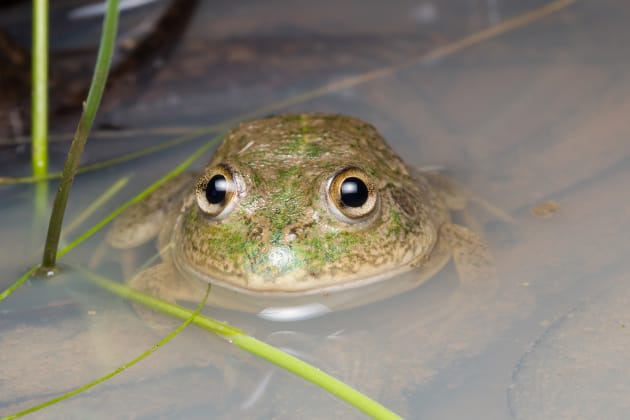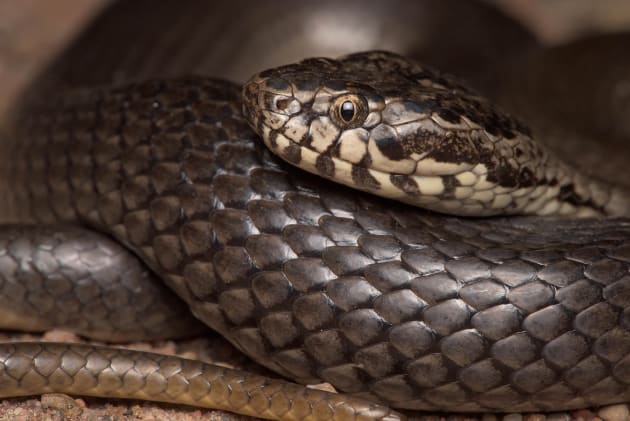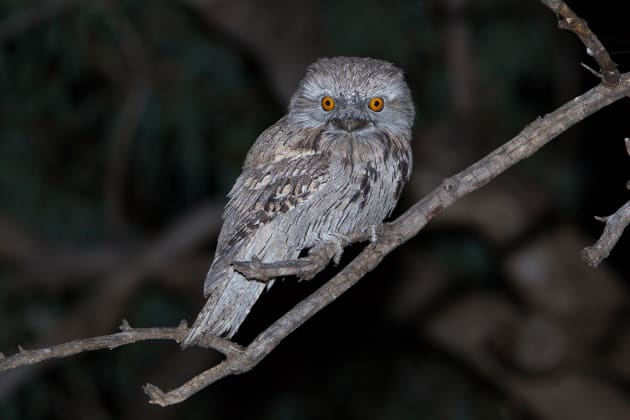Photo tip of the week: Capturing Australian wildlife after dark
Wildlife photographer Bruce Thomson knows a thing or two about night photography. Ahead of the release of his new book, Australian Wildlife After Dark, he speaks to Rob Ditessa about how unique camera setups help him to capture nocturnal wildlife in their natural environment.
Some images can take a great deal of time and effort, others aren't so easy. It depends on how high you set your sights, believes photographer Bruce Thomson.
“In some instances, the weather must be perfect, the animal must behave, and the camera system must work for a shot to come together,” he says.
To help increase his chances of capturing that once in a lifetime moment, Thomson has developed special systems to capture animals in flight or as they move in the bush, especially in the dark. These systems can catch an instant in the motion of a wing or a feature the eye would never see. It means he's able to take photographs that place an animal in the context of its habitat, or from a low, face-to-face perspective to give the viewer a sense of being right in the animal’s world.

Humble beginnings
Thomson says he remembers first becoming interested in photography as a teenager when his family lived on their country property near Bungonia in NSW.
“My uncle was a keen photographer and he started teaching me the basics as well as lending me his camera when he visited. Sometime later he bought some second hand Nikon gear for me and also found an enlarger which we installed in a back room in the house. So that was my starting point with black and white film which I developed and printed at home. I still have a large box of prints from that era in my wardrobe. It was all a very long time ago, but I doubt that I would have taken such in interest in photography if it hadn’t been for my uncle.”
But rather than dedicate his time purely to photography, Bruce Thomson has worked as a biologist for more than thirty years. As he explains, both fields satisfy two passions. It provides the chance to interact with the natural world and study animals closely. He also finds satisfaction in using available technology to produce a great image others can appreciate.
“With the many thousands of images now being taken by so many people, I hope that some of my images may stand out from the crowd. The fact is however, that I don’t take photographs to please others. I take them to please myself. If others like them, then that’s a bonus,” he enthuses.

The challenge
Successful photography of many wildlife subjects requires careful observation, a great advantage coming from a science background. To be at the right place at the right time, it's critical to understand the regular movement patterns of animals, habitat preferences and individual behaviours. But being a biologist has disadvantages, Thomson says, because many biologists have no formal training in photography, and while you can work out the basics with trial and error, there are some technical aspects of lighting, design and other considerations that most people need help with. One example is the poor use of flash resulting in a flat uninspiring image.
“What I really like is where you see mastery over the lighting, and especially if it’s mastery over a lighting system set up in the bush. That’s really something because it's so difficult. You are putting your skills to good use if you can do that because it takes you so far away from a studio where you can control everything. Out in the undergrowth with an animal, you can’t control everything. How much can you control is the interesting aspect of taking photographs, and it’s what separates the really fantastic photographs from the mediocre,” says Thomson.
The system
Keen to take his photographs to the next level, and with the help of a friend who is adept with electronics, Thomson built a camera system with the capacity to capture in flight images of insects, birds, “and in fact anything that flies”.
To test it out, he used it on local brush-tail possums. Recently he has been working on the development of a camera trap system using the Nikon D800E and D810.
He uses multiple flashes set with the aid of a light meter. The front cover of his new book was taken with this system.
“In setting up any system, I always consider the subject animals as a priority and I never work near a nest or other sensitive site where I might disturb animals. In cases where I photograph bats in flight, like at a cave entrance, I move quietly and do the setting up in total silence. I use two infrared beams at right angles such that both beams have to break together to trigger an image.
“One of the greatest challenges with in flight work is to overcome shutter lag, the time taken between the breaking of the beams and the moment that the camera fires. This is often about 1/30th second. At normal flight speeds for most aerial subjects, if the beam was connected directly to fire the shutter, the subject would be long gone from the image area before the photo was taken.
“Luckily, the control box that my friend built takes care of this problem and provides three different options to manage this. My lighting has to be reasonably high speed as well, and so I use numerous Vivitar 283s dialled down to minimum power which gives about 1/30,000 second. These old flashguns are true workhorses and I now have a collection of about 20 of them plus spare parts and the repair manual to do my own repairs.
“The camera trap system is quite different in that I don’t expect to have subjects zooming past at six metres per second. In fact the trap system uses a passive infrared detector to turn the system on and then fire the camera. The period between movement detection and the first image being taken is four seconds, although I can program this to be as long or short as needed, within reason. I need to allow at least some time between initial activation and camera firing to allow the flashes to charge fully.”
Thomson isn't tied to one camera system. “I have used both Canon and Nikon systems, and neither is ‘perfect’ for wildlife. When you buy into a system, you also buy into their particular shortcomings, but I don’t think one is necessarily ahead of the other in terms of what you can achieve with them. I have Nikon at the moment and my choice is the larger megapixel Nikons, the D800E and D810.
“I tend to use a wide angle lens for the camera trap, an 18-40 mm zoom. But for other subjects, I use the Nikon 18-35 mm f/3.5 - 4.5 G, and the Nikon 100 mm f/2.8 macro. On occasion I also use a Nikon 80-400 mm f/4.5 - 5.6. For telephoto shots, I use a Nikon 600 mm f/4 G and 1.4x Nikon converter which is a TC14-E III and I add a 1.4 converter to get me up to 800 mm on occasions.”

The composition
A good wildlife image is as much about the subject as it is about the technical aspects of the image, and the best images are where these two aspects come together to create something special, says Thomson. He refrains from claiming which are his better shots because, he says, they say ‘beauty is in the eye of the beholder’ and it is not up to him to make these judgements.
The ‘reasonably ok’ images are usually of subjects where he did not have time to set up lighting or have a chance to get into the best position. In those cases, he hopes the subject itself creates enough of an impression to be acceptable, in spite of a single flash and general lack of technical merit. At the ‘better’ end of the spectrum, he carefully plans a setup based on what he knows about the subject’s behaviour, uses multiple light sources, and spends a long time considering various perspectives and lens options.
“Then I need the subject to co-operate,” he notes.
The animal can be anywhere within, or outside, the field of view when the camera fires. Thomson says since it takes four seconds from the time motion is detected to the moment that the first image is taken, he expects that the animal has moved into the field of view and closer to the camera rather than away. But it is sheer luck as to where the animal will actually be in the image. For this reason he relies on 36 megapixel Nikon cameras.
“It allows me to do some serious cropping of the image to get the best composition in the RAW conversion and still have a reasonably large image. I normally output the final image as at 16 megapixel which is fine for most publication purposes and it meets the standards required by my photographic agency in the USA,” he says.

Work-flow and post
Coming from a film background, Thomson’s instinct is to get everything absolutely perfect in camera. He uses Lightroom because he does not do a lot of manipulation, and uses Photoshop very rarely. When he does bring an image into the program, Thomson says that at the back of his mind he is thinking of the shot as a second rate photo because he's had to manipulate it. He shoots in RAW, edits in camera, discards his unwanted material and brings the rest into a working directory. He stores images at 16 megapixels in JPEG and several copies of the RAW files for which he keeps an index to search by animals, plants, country, scientific name, common name, or just a generic term.


